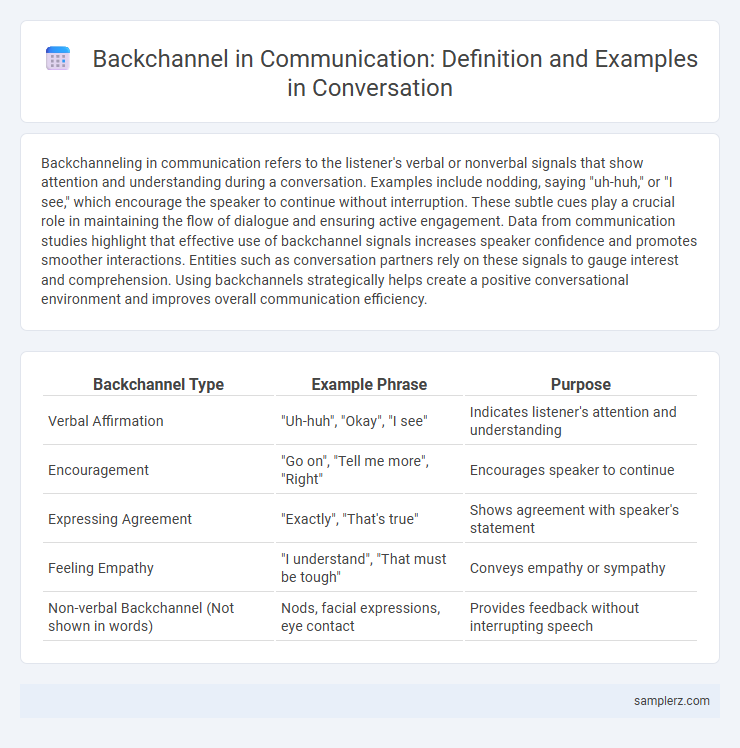Backchanneling in communication refers to the listener's verbal or nonverbal signals that show attention and understanding during a conversation. Examples include nodding, saying "uh-huh," or "I see," which encourage the speaker to continue without interruption. These subtle cues play a crucial role in maintaining the flow of dialogue and ensuring active engagement. Data from communication studies highlight that effective use of backchannel signals increases speaker confidence and promotes smoother interactions. Entities such as conversation partners rely on these signals to gauge interest and comprehension. Using backchannels strategically helps create a positive conversational environment and improves overall communication efficiency.
Table of Comparison
| Backchannel Type | Example Phrase | Purpose |
|---|---|---|
| Verbal Affirmation | "Uh-huh", "Okay", "I see" | Indicates listener's attention and understanding |
| Encouragement | "Go on", "Tell me more", "Right" | Encourages speaker to continue |
| Expressing Agreement | "Exactly", "That's true" | Shows agreement with speaker's statement |
| Feeling Empathy | "I understand", "That must be tough" | Conveys empathy or sympathy |
| Non-verbal Backchannel (Not shown in words) | Nods, facial expressions, eye contact | Provides feedback without interrupting speech |
Understanding Backchannels in Everyday Conversations
Backchannels in conversation, such as nodding, saying "uh-huh," or brief affirmations like "I see," signal active listening and understanding without interrupting the speaker. These subtle cues enhance communication by providing feedback that the message is being processed, reinforcing engagement and clarity. Recognizing and using effective backchannels helps maintain conversational flow and strengthens interpersonal connection.
Common Verbal Backchannel Examples
Common verbal backchannel examples in conversation include short utterances like "uh-huh," "yeah," and "right," which signal active listening and engagement without interrupting the speaker. Phrases such as "I see," "okay," and "got it" also serve as feedback indicators, encouraging the speaker to continue. These verbal cues maintain conversational flow and demonstrate attentiveness in interpersonal communication.
Nonverbal Backchannel Signals in Dialogue
Nonverbal backchannel signals in dialogue include nodding, eye contact, and facial expressions that indicate active listening and engagement without interrupting the speaker. These cues help regulate the flow of conversation, conveying understanding and encouragement. Effective use of nonverbal backchanneling enhances communication by creating a supportive interaction environment.
Cultural Variations in Backchanneling
Backchanneling behaviors vary significantly across cultures, with Japanese speakers frequently using "aizuchi" such as "hai" or "un" to signal attentiveness without interrupting, while American English speakers rely on verbal cues like "uh-huh" and nonverbal gestures such as nodding. In Latin American cultures, listeners often provide more frequent verbal and physical backchannels to encourage speaker engagement, contrasting with Northern European norms where minimal backchanneling reflects politeness and respect for silence. Understanding these cultural variations is crucial for effective intercultural communication and avoiding misunderstandings in conversational dynamics.
The Role of Backchannels in Active Listening
Backchannels such as "uh-huh," nodding, and brief verbal affirmations signal active listening and encourage speakers to continue without interruption. These subtle responses facilitate smoother communication by confirming understanding and fostering engagement in conversations. Effective use of backchannels enhances rapport and strengthens interpersonal connections in both personal and professional settings.
Backchannels in Digital Communication
Backchannels in digital communication, such as emojis, read receipts, and typing indicators, provide real-time feedback that signals attentiveness and understanding during conversations. These subtle cues enhance conversational flow by allowing participants to respond non-verbally without interrupting the speaker. Platforms like WhatsApp and Slack utilize backchannels to maintain engagement and foster smoother interactions in virtual environments.
The Impact of Backchannels on Conversation Flow
Backchannels such as "uh-huh," "I see," and nodding play a crucial role in maintaining conversation flow by signaling active listening and encouraging the speaker to continue. These subtle verbal and nonverbal cues reduce misunderstandings and create a more dynamic and interactive communication environment. Research shows that effective use of backchannels enhances speaker confidence and improves the overall coherence of dialogues.
Effective Ways to Use Backchannels
Backchannels such as nodding, "uh-huh," or brief verbal affirmations play a crucial role in maintaining conversational flow and demonstrating active listening. Using these cues strategically, like emphasizing agreement during key points, helps build rapport and ensures the speaker feels understood without interrupting their speech. Employing backchannels effectively enhances communication clarity and strengthens interpersonal connections by signaling engagement and encouraging further dialogue.
Challenges of Misinterpreted Backchannels
Misinterpreted backchannels, such as nods or brief verbal affirmations like "uh-huh," often cause challenges in communication by leading to unintended meanings or false assumptions. For example, a listener's nod may be wrongly interpreted as agreement rather than understanding, resulting in confusion or conflict. These misinterpretations highlight the need for clearer feedback mechanisms to ensure accurate message decoding in conversations.
Backchannel Usage in Professional Settings
Backchannel usage in professional settings includes subtle cues such as nodding, brief verbal affirmations like "I see" or "Go on," and maintaining eye contact to indicate active listening without interrupting the speaker. These non-intrusive signals foster engagement, reinforce understanding, and help maintain the flow of conversation during meetings or presentations. Effective backchanneling enhances communication clarity, supports collaborative decision-making, and builds rapport among colleagues.

example of backchannel in conversation Infographic
 samplerz.com
samplerz.com